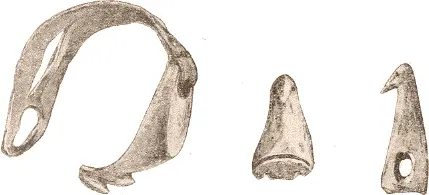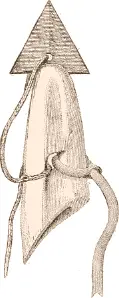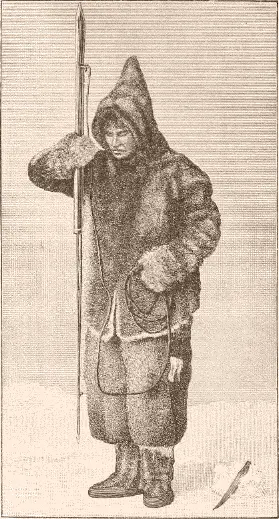If the unang has a nabiring the line passes through this loop. A few feet below it a small piece of ivory (akparaiktung) is attached to the line, acting as a hook after it has run out. It catches the nabiring and drags the harpoon along, thus impeding the movements of the animal (see Fig. 391).

Fig. 394. Qilertuang or leather strap and clasps for holding coiled up harpoon lines.
a , c (National Museum, Washington. a , 34128; c , 34132.) b (Museum für Völkerkunde, Berlin.) 1/1
The rest of the line is coiled up and held by the hunter. The end is doubled so as to form a loop which serves as a handle when the line runs out with the diving seal. Generally, a small piece of leather (Fig. 394) with two slits at one end and an ivory clasp (qilertuang) at the other is fastened to this loop; it serves to hold the bights together when the line is detached from the harpoon and rolled up. Some art is bestowed on the manufacture of this clasp (Fig. 394). Usually it represents a seal, the head of which forms a hook on which the slits can be fastened. The clasp is either tied or otherwise secured to the leather strap. Some specimens in the British Museum, which are about one hundred and fifty years old, show that these implements have not undergone any change during that time.
Parry describes another harpoon head used by the Iglulirmiut for the unang. He calls it a siatko (Fig. 395). I myself have not seen any of a similar pattern, but Kumlien gives a sketch of one found in a grave at Exeter Sound (Fig. 396). The principal difference between the naulang and the siatko is that the edge of the former is parallel to the hole through which the line passes, while in the latter their directions are vertical to each other. The head of the whaling harpoon (see Fig. 436) acts on the same principle.

Fig. 395. Siatko or harpoon head of the Iglulirmiut. (From Parry II, p. 550.)

Fig. 396. Siatko found at Exeter Sound. (From a drawing by L. Kumlien.)
When the day begins to dawn the Eskimo prepares for the hunt. The dogs are harnessed to the sledge and the hunting implements are fitted up. The harpoon line and the snow knife are hung over the deer’s antlers, which are attached to the hind part of the sledge, a seal or bear skin is lashed upon the bottom, and the spear secured under the lashing. The hunter takes up the whip and the dogs set off for the hunting ground. When near the place where he expects to find seals, the hunter stops the team and takes the implements from the sledge, which is then turned upside down. The points of the runners and the short brow antler are pressed into the snow in order to prevent the dogs from running away. A dog with a good scent is then taken from the team and the Eskimo follows his guidance until a seal’s hole is found. In winter it is entirely covered with snow, but generally a very small elevation indicates the situation. The dog is led back to the sledge and the hunter examines the hole to make sure that it is still visited by the seal. Cautiously he cuts a hole through the snow covering and peeps into the excavation. If the water is covered with a new coat of ice the seal has left the hole and it would be in vain to expect its return. The hunter must look for a new hole promising better results.

Fig. 397. Eskimo in the act of striking a seal. (From a photograph.)
If he is sure that the seal has recently visited a hole he marks its exact center on the top of the snow and then fills up his peep hole with small blocks of snow. All these preparations must be made with the utmost precaution, as any change in the appearance of the snow would frighten away the seal. The Eskimo take particular care that no hairs from their clothing fall into the hole or remain sticking in the snow, for they believe that the smell would scare away the animal. The center of the breathing hole must be marked, as the game remains invisible and only a stroke into the center will be likely to hit it. If the snow covering is very thick and strong it is cut down, but is replaced with loose snow, which is heaped around the end of the harpoon, the latter being placed upon the central point. After the harpoon has been extracted a hole remains which forms the mark for the harpooner. If the Eskimo expects the early return of the seal, he spreads a small piece of skin, generally that of a young seal, close to the hole and places his feet upon it, thus keeping them warm. He fastens the naulang to the harpoon shaft, while the lower end of the line is folded up in a coil, which he holds in the left hand. The unang is held in both hands, and thus the hunter sometimes remains for hours, occasionally stooping and listening, until he hears the blowing of the seal. Then, all of a sudden, he stands upright, and, with all his strength, sends the harpoon straight downward into the hole, paying out the line at the same time, but keeping a firm hold of the loop at its end (Fig. 397). Generally the seal is struck near the head. If the line is fastened to the shaft by a slipping hitch it is at once detached and the harpoon either remains sticking in the snow or falls down by the hole. If the line runs through the nabiring, the harpoon is dragged into the water and impedes the movements of the animal. The hunter then begins at once to cut down the snow covering with his knife, which has been left within easy reach, and hauls in the line. As soon as the seal comes to the surface to breathe it is easily dispatched and drawn up on the ice.

Fig. 398. Tutareang or buckle. (Museum für Völkerkunde, Berlin. IV A 6710.) 1/1
The arrangements at the seal hole are more elaborate if the sealer expects to wait a long time. If only a few men go out hunting and famine is impending, he sometimes waits for a whole day or even longer, though it be cold and the wind rage over the icy fields. He builds up a semicircular wall of snow blocks to keep off the piercing wind and makes a seat in the center of it. A skin is spread under his feet and his legs are tied together with a thong, which is fastened by a peculiar kind of buckle (tutareang) with two holes (Fig. 398). One end of the thong is firmly tied to the buckle, passing through one of the holes, while the opposite end passes tightly through the second hole. The thong may be quickly opened by a strong effort on the part of the hunter, while it helps to keep him quiet. At his right hand (Fig. 399; in this drawing it appears on the left) the snow knife is stuck into the snow, while to the left the unang is placed upon two pegs. The coil of the line lies in his lap. His left arm is drawn out of his sleeve, that he may more easily keep warm. Both sleeves are generally held together by a piece of deer’s horn with a branch on each side which serves as a hook. Thus the hunter waits until he hears the breathing of the seal. As it usually stays for several minutes he is in no hurry to get ready. Cautiously he places his left arm into the sleeve, having first disengaged it from the hook. He then takes hold of the coil, picks up his unang, and, having risen, strikes the center of the hole.
Читать дальше

















